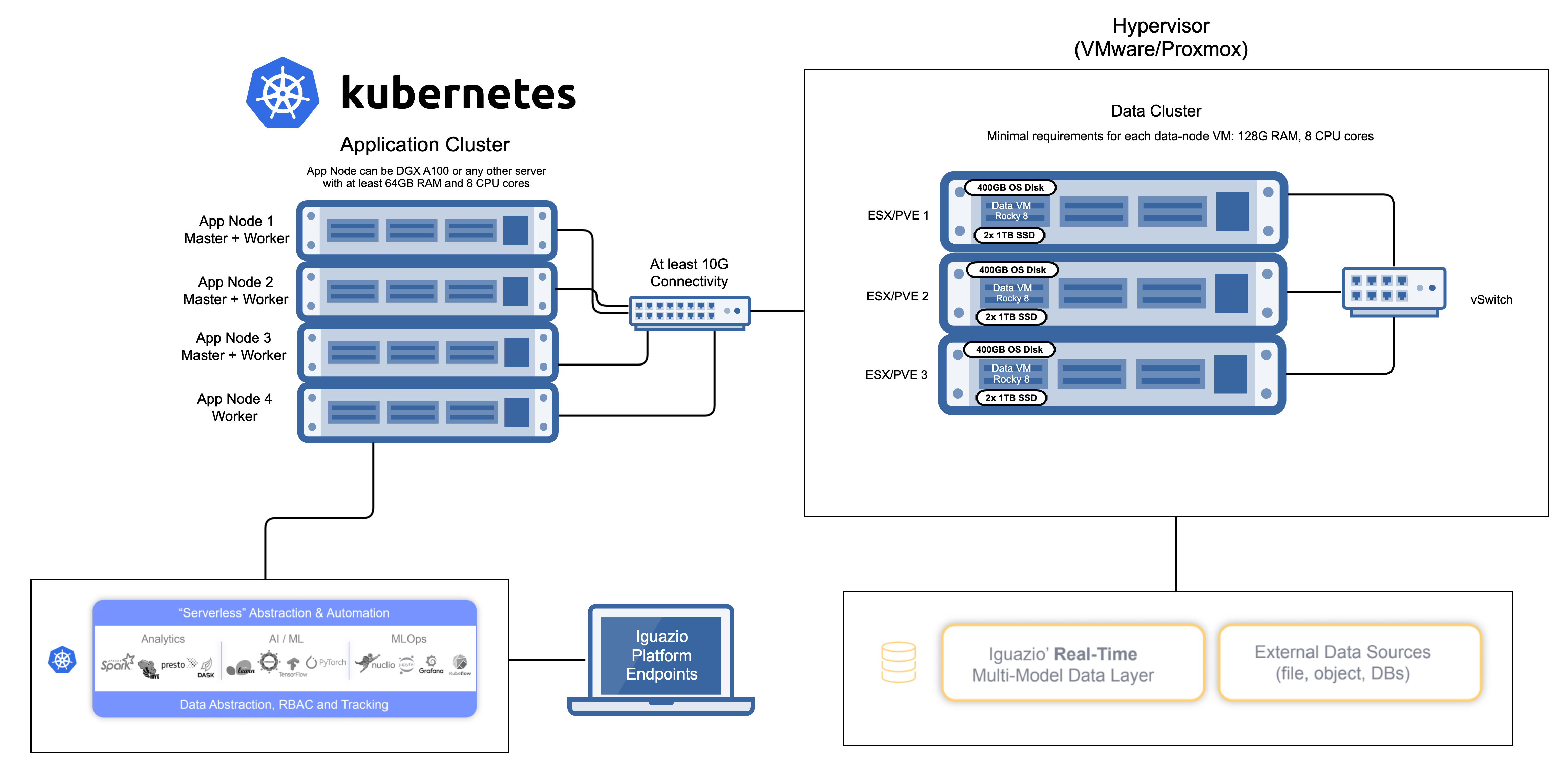On-Premises Deployment Specifications
Overview
This document lists the hardware specifications for on-premises ("on-prem") deployment of version 3.6.1 of the Iguazio AI Platform ("the platform").
Hardware Configurations
- Iguazio Playground
A single data-node and single application-node cluster implementation. This configuration is designed mainly for evaluation trials and doesn't include high availability (HA) or performance testing.
NoteYou can deploy a Proof of Concept (POC) in the Iguazio playground configuration. Be aware that the POC cannot be used as development environment or for a production environment.
- Operational Cluster
- A scalable cluster implementation that is composed of multiple data and application nodes. This configuration was designed to achieve superior performance that enables real-time execution of analytics, machine-learning (ML), and artificial-intelligence (AI) applications in a production pipeline. The requirement for HA support is three data nodes and a minimum of three application nodes.
For both configurations, data nodes in on-prem deployments are always deployed on virtual machines (VMs) while application nodes can be deployed on either VMs or local machines (bare-metal).

VM Deployment Notes
-
Provisioning (deployment) of the platform's node VMs is done by using a dedicated virtualization package, provided by Iguazio.
Don't attempt to provision the servers yourself prior to the deployment. -
Platform shutdown should be coordinated with Iguazio's support team.
Don't shut down the data-node VMs non gracefully, as this might erase the data.
When deploying on virtual machines, notify Iguazio's support team whenever VMware Enhanced vMotion Compatibility (EVC) mode is enabled, as a low EVC level might disable required CPU features.
VM Hypervisor Host Specifications
Hypervisor host machines in VM platform deployments must fulfill the following hardware specification requirements:
| Component | Specification |
|---|---|
| Network interfaces |
|
| Hypervisor | VMware vSphere ESXi 6.5, 6.7, 7.0, or Proxmox VE (PVE) 6.x or 7.0 |
If you want to configure your VM Hypervisor for High Availability:
- Each of the VM Data Nodes must run on different hypervisors.
- For at least 3 application nodes: each of those VM Application Nodes must run on different hypervisors. The rest of the VM Application Nodes can run more than one on same hypervisors.
- One VM Application node and one VM Data node can use same hypervisor
VM Data-Node Specifications
Data nodes in on-prem platform deployments are VMs that must fulfill the following hardware specification requirements.
| Component | Specification |
|---|---|
| Memory | 64 GB (POC node) / 128 GB (small node) / 256 GB (large node) |
| Cores | 4 (POC node) / 8 (small node) / 16 (large node) |
| VM boot disk | 400 GB (minimum) image (hosted on an enterprise-grade SSD-based data store) |
| Data disks | 2 (POC node) / 2, 4, 6, or 12 (small node) / 2, 4, 6, 8, or 12 (large node) NVMe or enterprise-grade SSD data disks (drives) of 1 TB (minimum) each, which are mapped exclusively to the data-node VM using direct attach storage (DAS). |
Application-Node Specifications
In on-prem deployments you can select whether to deploy the application nodes on virtual machines (VMs) or on local machines (bare-metal), provided the same method is used on all nodes.
VM Application-Node Specifications
Application nodes in VM platform deployments are VMs that must fulfill the following hardware specification requirements.
| Component | Specification |
|---|---|
| Memory | 64 GB (small node) / 128 GB (large node) |
| Cores | 8 (small node) / 16 (large node) |
| VM boot disk | 400 GB (minimum) image (hosted on an enterprise-grade SSD-based data store) |
| GPU (Optional) | GPUs supported by the NVIDIA Linux display driver 470.129. |
Bare-Metal Application-Node Specifications
Application nodes in bare-metal platform deployments are supplied by the customer and must fulfill the following hardware specification requirements:
| Cores | 8 (minimum) |
| Memory | 64 GB of RAM (minimum) |
| OS boot disk | 400 GB (minimum) enterprise-grade SSDs |
| Network interfaces |
|
| GPU (Optional) | GPUs supported by the NVIDIA Linux display driver 470.129. |
Backing up the Platform
Allocate one NFS in your application node for backing up your platform. See full details in Backing Up the Platform.